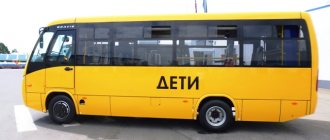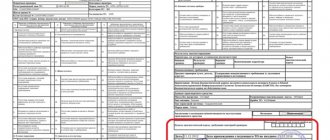Good afternoon, dear reader.
This article will discuss the rules for transporting groups of children on a bus . Over the past few years, several regulations related to this issue have been issued and amended. All of them were reviewed on pddmaster.ru.
This article contains generalized information and will be updated as legislation changes.
Please note that issues of organized transportation of children affect not only transport companies.
For example, if parents of schoolchildren want to organize an excursion for their children, then they will also have to comply with the transportation rules.
This article will discuss the documents required for transportation, requirements for buses and the people on them.
- traffic police document;
What is organized transportation of children?
Clause 1.2 of the traffic rules:
“Organized transportation of a group of children” - transportation on a bus that is not a route vehicle, a group of children of 8 or more people, carried out without their parents or other legal representatives.
Please note that organized transportation does not include:
- Children's ride on a minibus. For example, if children and their teacher go to the theater on trolleybus number 1.
- Transportation of 7 or less children.
- Transportation of 8 or more children and several parents, in which 7 or less children are traveling without parents.
Organized transportation includes transportation when:
- People travel on a bus that is not a route vehicle.
- Among the people there are at least 8 children whose parents are not present on the bus.
If the above conditions are met, then you should read this article to the end and study the transportation rules.
Rules for transporting children at night and during the day: nuances
There are a number of nuances that the trip organizer needs to take into account directly when implementing it. In particular:
- Persons not included in the list of passengers should not be allowed to board the bus (clause of the Rules). For example, parents of children cannot be placed on the bus if they are not included in this list.
- In case of unfavorable road conditions, due to which the departure time is changed, the transportation organizers or one or another party to the charter agreement notify the children’s parents about the corresponding changes in the travel plan (clause of the Rules). Accompanying persons, medical workers, and the traffic police, which allocated a vehicle to accompany the transportation, must also be notified of the changes.
Participants of organized transportation
Currently, the list of persons who can participate in organized transportation is strictly limited. Clause 14 of the rules for transporting children by bus:
14. If a child or other person included in the list fails to appear, information about him or her is deleted from the list. In addition to the driver (drivers), other persons other than those indicated in the lists are not allowed on the bus. Monitoring compliance with these requirements is the responsibility of accompanying persons.
Only :
- driver(s);
- children included in the passenger list;
- accompanying persons included in the list of passengers;
- a medical worker included in the passenger list.
Please note that the legality of each person on the bus must be confirmed by an appropriate document. You cannot take a person on a trip without a document.
As an example, consider the following situation. The 11th grade of a secondary school is going on a tourist trip. At the same time, some students have reached the age of 18, i.e. they are not children. The rest of the class remains children. How to prepare documents in this case?
It's actually quite simple:
- Students under 18 years of age must be listed as children on the passenger list;
- Students over 18 years of age must be included on the passenger list as accompanying passengers.
Let's take a closer look at each of the trip participants.
Bus driver
The driver must meet the following requirements:
- working as a category D driver for 1 year out of the last 2 years (until January 1, 2021 - 12 out of the last 13 months);
- undergo pre-trip briefing;
- absence of punishment in the form of deprivation of rights or administrative arrest during the last year.
Children
Children under 18 years of age must be included as children on the passenger list.
Moreover, if there is at least one child under 7 years of age on the list, then the bus schedule must be drawn up so that the bus does not travel longer than 4 hours. That is, we are talking about the total duration of the trip. So it won’t be possible to take small children on long trips.
Accompanying
All accompanying persons must be included in the passenger list as accompanying persons.
Accompanying persons are assigned to each of the buses involved in transportation. The minimum number of accompanying persons is 1 person at each bus door intended for boarding.
If the bus has 2 doors, then there must be at least two accompanying people.
Note. From 1 January 2021, only 1 accompanying person is allowed on the bus if the group includes 20 children or less. In this case, passengers board and disembark through one door of the bus, near which there is an accompanying person.
The maximum number of accompanying persons is not limited.
For example, 8 children and 30 accompanying persons can travel on a bus.
One of the accompanying persons on each bus is designated as responsible.
a senior responsible escort is also appointed . Until October 1, 2019, the senior person in charge could only travel on the last bus in the convoy. After October 1, this requirement is canceled and the senior accompanying person can ride on any bus.
Adult passengers
All adult passengers on the bus must be included on the passenger list as companions.
Medical worker
A medical professional is only required if the trip meets both the following conditions:
- the trip is intercity (until January 1, 2021);
- the duration of the scheduled trip exceeds 12 hours;
- there are 3 or more buses in a convoy (from January 1, 2021).
From October 1, 2021, a medical worker can travel on any bus in the convoy. Previously, he was supposed to be on the last bus.
Requirements for drivers transporting children
8. Drivers who have continuous experience as a driver of a category “D” vehicle for at least 1 year and who have not been subjected to administrative punishment in the form of deprivation of the right to drive a vehicle or an administrative penalty during the last year are allowed to drive buses carrying out organized transportation of a group of children. arrest for committing an administrative offense in the field of traffic.
8. Drivers who meet the following requirements are allowed to drive buses carrying out organized transportation of a group of children:
- having worked as a driver of a category “D” vehicle for at least one year out of the last 3 calendar years;
- have not committed administrative offenses in the field of road traffic, for which administrative punishment is provided in the form of deprivation of the right to drive a vehicle or administrative arrest, during the last year;
- who have undergone pre-trip instruction on the safety of transporting children in accordance with the rules for ensuring the safety of transportation of passengers and cargo by road and urban ground electric transport, approved by the Ministry of Transport of the Russian Federation;
- have undergone a pre-trip medical examination in the manner established by the Ministry of Health of the Russian Federation.
Just as before, drivers carrying out organized transportation of children should not have been punished in the form of deprivation of rights or administrative arrest during the last year.
Until 10 July 2015, drivers were also required to have continuously worked as a Category D driver for the past year. This requirement is becoming more loyal to drivers. Starting from July 10, it is enough to have one year of experience out of the last three years .
For example, the following situation could have happened earlier. A person has been working as a driver of category D all his life. However, half a year ago he switched to a new job (also as a driver of category D). During a change of workplace, the work experience was interrupted for 1 day. Until July 10, 2015, such a driver was not allowed to organize the transportation of children. After July 10th there is no such restriction.
Attention! On October 1, 2021, the requirements for bus drivers were once again updated. Starting from this date, work experience as a driver is required for 12 months out of the last 13. You can find out more about the innovations in a separate article.
New requirements for drivers from July 10, 2015:
- Completion of pre-trip instruction on the safety of transporting children.
- Passing a pre-trip medical examination.
Documents for organized transportation
Traffic police document
If transportation is carried out by one or two buses, then a copy of the traffic police notification .
Submitting a notification to the traffic police
If the transportation involves 3 or more buses, then a copy of the traffic police decision on assigning an escort or refusing to provide an escort is required. In case of a positive decision on the application, the convoy of buses is accompanied by one or more police vehicles.
List of all passengers
From October 1, 2021, all passengers can be included in a single list , that is, issuing separate lists for children, accompanying and adult passengers is not required.
For example, the list might look like this:
| Full Name | Additional Information | |
| child | Ivanov Ivan Ivanovich | Age: 12 years. Parents' phone number |
| accompanying | Petrov Petr Petrovich | Telephone |
| accompanying | Volkov Arkady Dmitrievich | Telephone |
When filling out information about children, instead of the “Age” column, the “Date of Birth” column can be used.
Note. If a medical professional is involved in the trip, he must also be included in the passenger list. In addition, a license to carry out medical activities or an agreement with a medical organization must be attached.
Driver's document
Attention! From January 1, 2021, an additional driver document is no longer required .
The driver's document must indicate his full name and telephone number. If there are several drivers, then the document indicates the details of each of them.
Please note that we are not talking about a driver's license. A separate document is required, which must be prepared by the transportation organizer.
In addition, you don’t have to issue if the documents include a copy of the traffic police notification about the transportation. Such notification is mandatory if the transportation involves 1 or 2 buses.
Procedure for boarding passengers on the bus
Attention! From January 1, 2021, passenger boarding procedures are no longer required .
The order of boarding passengers includes information about how exactly it is controlled that exactly the passengers from the list got on the bus:
- according to documents (official ID, travel voucher, student card);
- according to the list of passengers;
Transportation route
Transportation route information must include:
- point of departure;
- intermediate pick-up/drop-off points;
- destination;
- stopping places for food and rest.
Note. Before October 1, 2021, a traffic schedule was also required, which should have indicated the time of arrival at different points along the route.
Additional documents
Documents that the driver must have only in some cases:
- The charter agreement or a copy thereof (if such an agreement was concluded).
- List of a set of food products if children are traveling for more than 3 hours (until January 1, 2021).
Please note that the originals of all the documents listed above must be kept for 90 days from the date of the trip , and if an accident involving victims occurred during the trip, then for 3 years.
Rules for the carriage of unaccompanied children
Dear passengers! Please note that on international routes there are additional requirements of Rospotrebnadzor regarding formalities when filling out questionnaires from countries of entry and forms on the State Services website. In this regard, the service for transporting unaccompanied children on international flights is temporarily not provided.
The airline accepts unaccompanied children for transportation. Transportation of unaccompanied children is carried out only on direct airline flights or to the first boarding point. The number of unaccompanied children on a flight is limited.
Children aged (the age of the child is determined on the day of commencement of transportation) are transported as unaccompanied children:
- From 5 to 12 years when flying within Russia and the CIS;
- From 6 to 12 years when flying to foreign countries.
At the request of parents, guardians (trustees), the escort service can be provided for children over 12 years of age.
The service can be obtained at the airline representative office, at the airline's branded ticket offices, agent offices or through the Call Center:
- Order the service for transporting an unaccompanied child no later than 72 hours before flight departure
- Purchase an air ticket for a child at the rate for an adult passenger
- Fill out an application for transportation of an unaccompanied child in 4 copies (Application form);
- Pay for the service.
Cost of service (per flight segment):
- On flights within Russia, the CIS and Georgia – 5,000 rubles. RF
- On flights to non-CIS countries – 100 euros
Prices are valid from January 21, 2021.
Registration of unaccompanied children for a flight is carried out only at the check-in counter at the airport of departure, this will allow our employees to take care of your child while going through all the formalities at the airport of departure and arrival.
Please note that in the case of transporting an unaccompanied child to an international destination, only the child’s legal representatives can deliver the child to the airport of departure and register him for the flight: parents, adoptive parents, guardians, trustees or representatives of the child with a notarized power of attorney from the child’s legal representatives.
- Documents required to register a child for transportation
Transportation of unaccompanied children across the territory of the Russian Federation
- An identification document of the applicant and a document certifying the relationship between the child and the applicant (birth certificate, adoption certificate, document confirming the establishment of guardianship or trusteeship) or a notarized power of attorney from the child’s legal representatives;
- Air ticket for a child;
- Identification document of the child (for citizens of the Russian Federation): - Birth certificate of the child - for children under 14 years old or passport of a citizen of the Russian Federation - for children over 14 years old;
- Application for transportation of an unaccompanied child in 4 copies (Application form); Be careful when filling out the Application. Please see the Example of filling out the Application.
- Receipt confirming payment for the service;
- Medical certificate about the child’s health status (if necessary).
Transportation of unaccompanied children on flights to CIS countries and non-CIS countries
*If one of the parents, adoptive parents, guardians or trustees declares his disagreement with the departure of a minor citizen of the Russian Federation from the Russian Federation, the issue of the possibility of his departure will be resolved in court.
ATTENTION:
It is possible to arrange transportation of an unaccompanied child to Kyrgyzstan using a birth certificate for a child under 14 years of age (Russian birth certificate), a passport of a citizen of the Russian Federation for a child over 14 years of age, or a foreign passport.
Air does not provide a service for transporting an unaccompanied child to/from the United Arab Emirates
The person accompanying the child must remain at the airport until the flight departs.
The person meeting you at the arrival airport, specified in the Application, must provide an identification document.
The person you specify in the application to meet your child must be at the airport at the time of flight arrival and have a valid identification document with him.
Bus for organized transportation
Paragraph 22.6 of the traffic rules:
22.6. Organized transportation of a group of children must be carried out in accordance with these Rules, as well as the rules approved by the Government of the Russian Federation, on a bus marked with identification marks “Transportation of Children”.
requirements apply to the bus :
- Installation of a sign “Transportation of children”. The sign is installed in front and behind the bus.
- Turn on a yellow or orange beacon (starting from July 1, 2021).
- The bus must be equipped with seat belts (from October 1, 2021).
In addition, a bus for the organized transportation of children must meet the requirements for all buses for the transportation of passengers:
- The bus must comply in terms of purpose and design with the technical requirements for the transportation of passengers.
- The bus must be permitted to participate in road traffic.
- Installation of tachograph.
- Installation of GLONASS or GLONASS/GPS satellite navigation equipment (not valid from March 19 to May 31, 2021).
Transportation of organized groups of children by train
In order to transport an organized group of children by train, you must first purchase tickets. To purchase them you need:
- submit an application letter of a strictly established form;
- submit a list of passengers indicating document details (taking into account that there must be one accompanying person for every 10 children);
- attach a receipt for payment of miscellaneous fees;
- for a group of 30 or more children and a trip of 12 hours or more, a medical worker is required - information about him must also be attached;
- list of dry ration products - fill out a special form;
- attach a power of attorney (form M-2).
Applications must be submitted 45-60 days in advance. Applications submitted 10 days in advance may not be fulfilled if the trains in the desired direction are overloaded. A fee is charged for reserving seats, which is not refundable if you cancel the trip.
Note:
- a group ticket is one ticket listing all passengers;
- You can pay it in cash or by bank transfer;
- if you need to travel for more than a day, you need to conclude an agreement on the provision of hot meals with the dining car - if there are a lot of children, they will hook up an additional dining car with a children's menu, and it will be located next to the carriage in which the children are traveling;
- meals will be four times a day, calculated according to calorie content for each age;
- if you travel for less than a day, you need a packed ration, prepared in accordance with all the rules and approved by Rospotrebnadzor;
- the physician must monitor the health, hygiene and nutrition of children; it has two styling - general and anti-pediculosis;
- all children must have certificates stating that they are healthy and have not been in contact with infectious patients;
- children can only be transported on trains with new types of dry closets;
- conductors must clean the carriage at least twice a day, and the toilet every 6 hours;
- At stations, a group of children must be accompanied by a station employee who monitors their safety.
Documents that will help you prepare for your train trip:
- Federal Law 18 of January 10, 2003 “Charter of Railway Transport of the Russian Federation”;
- Order of the Ministry of Transport 473 of December 19, 2013 “Rules for transportation... by rail”;
- Order of Russian Railways No. 1493r dated 06.0807 “On the procedure for organizing and ensuring the safety of transportation of organized groups of children”;
- Resolution of the Chief Physician of the Center for Sanitary and Epidemiological Epidemiology dated January 21, 2014 “On approval of Sanitary and Epidemiological requirements for the transportation of organized groups of children by rail.”
Fasten the fidget
A new decree of the Government of the Russian Federation, amending the Rules for the organized transportation of a group of children by bus, defines the requirements for both trip organizers and accompanying persons and carriers. As explained by the Russian Ministry of Internal Affairs, all buses carrying groups of children must be equipped with seat belts, and young passengers must wear them during the trip. Previously, similar requirements were imposed only during intercity transportation of children; this rule did not apply to suburban and city trips.
The innovations do not apply to school buses, since a school bus, even if it carries only children, is a route vehicle. And according to the current traffic regulations, organized transportation of a group of children, to which special rules apply, including from October 1, 2021, is carried out on buses that are not route buses. Quite significant penalties are still provided for violations of the rules for transporting a group of children. So, if the bus does not comply with the rules, there is no charter agreement, or the driver does not comply with the duties, follows without a route program, an accompanying person or without a list of children, he will be fined in the amount of 3 thousand rubles. For officials and legal entities the amount will be 25 and 100 thousand, respectively.
The requirements for the buses themselves, transporting children, boil down to the fact that they must be in good condition and have permission to participate in the transportation of children and road traffic in general, equipped with a tachograph, as well as a Russian satellite navigation system. From July 2021, such vehicles must be no older than 10 years. Previously, requirements for the year of manufacture of a bus concerned individual categories and regions. Also new here is the requirement that buses be equipped with seat belts for children.
From July 2021, buses for organized transportation of children must be no older than 10 years
The State Traffic Inspectorate notes that the “children’s” resolution that has come into force simplifies the organization of transportation, and the innovations themselves are aimed at increasing the safety of such transportation and simplifying the procedure for their registration. Let us remind you that the activities of the federal project “Road Safety” are being implemented at the federal and regional levels today. In accordance with the project targets, by 2024 the mortality rate should be reduced by 3.5 times to a figure not exceeding 4 deaths in road accidents per 100 thousand population. Particular attention in the federal project is paid to the transportation of children.
Automakers declare their readiness to meet all necessary requirements. As IVECO emphasized, these changes in the complex pursue one clear goal, which is to increase the safety of transporting children and reduce accidents.
As for the specific requirement to limit the maximum “age” of buses, this is an absolute benefit for equipment manufacturers, since, obviously, the demand for their products will increase.
But this, of course, is not an end in itself, since, we repeat, the new rules should first of all make the transportation of children safer. However, this is precisely what can cause certain difficulties. Let's take, for example, the financial aspect - any high-quality (read - safe) product involves significant costs both at the design stage and at the testing stage. IVECO, being one of the largest manufacturers of solutions for passenger transportation, simply cannot afford this now, although it constantly invests in the safety of its own vehicles, and produces cars suitable for transporting children, for example, the Crossway and Daily models.
“If we talk about organized transportation of groups of children, we order and sell mainly only new buses. Used buses are supplied only at the client’s request and for a specific task. In this regard, the implementation of the government resolution does not cause difficulties, and we do not need to change our strategy. In addition, we support limiting the age limit for vehicle operation; this contributes to the timely renewal of the fleet and strengthens road safety, which is extremely important for Russia,” MAN told RG.
Any high-quality (read: safe) product involves significant costs both at the design stage and at the testing stage
It is worth noting that such a market niche as passenger bus transportation of children in organized groups is developing quite steadily. Every day in Russia, on average, about 1,300 organized transportations of groups of children are carried out. At the same time, new requirements for the year of production of buses intended for children's transportation may, to a certain extent, become some incentive to update the fleet. Thus, according to the analytical agency AUTOSTAT, in September 2021, the market volume of new buses in Russia amounted to 1,233 units. This is 28.6 percent more than a year earlier. The leadership in the market is held by the domestic PAZ, which accounted for 57 percent of production, or 706 copies. Second place belongs to the Russian brand LiAZ, sales of which in the first month of autumn increased 3 times, to 205 units. NefAZ took third place (87 units; +85 percent). Moscow purchased the most new buses, with Krasnodar Krai in second place and Bashkortostan in third place, where sales of new buses last September were 10 times higher than last year’s figures. Experts note that over 9 months from the beginning of the year, sales in this segment also increased - by 9 percent, to 9.8 thousand units. Meanwhile, in the Russian bus fleet there are almost 50 thousand Soviet-made vehicles. At the beginning of the year, their share was 12 percent of the country's entire bus fleet.
It is obvious that the implementation of federal projects in the field of road activities, increasing the efficiency of supervision over the activities of road and vehicle owners, improving management, as well as forms and methods of monitoring compliance by road users with the requirements and norms of the law will not only contribute to increasing the level of safety on the country's roads , but also to update the vehicle fleet.
A comment
Grigory Mikryukov, head of the department of economic sectors of the Analytical Center for the Government of the Russian Federation:
— Updating the fleet of vehicles by banning the use of “old” vehicles is an effective, but quite tough measure. And before using it, you need to weigh the pros and cons for all participants. Obviously, bus manufacturers will benefit in the short term. At the same time, given the high competition from Chinese manufacturers, Russian factories may not receive the expected increase in demand for their products. At the same time, carriers will be forced to incur additional costs, which in turn will try to pass on to consumers. In the case of replacing buses owned by budgetary organizations, this means either a refusal to use old buses or additional budgetary expenses.
In general, the bus fleet in Russia is quite old; it is desirable to update it, including taking into account new environmental and technological requirements.
Subsidizing the purchase of buses for social transportation to commercial organizations is ineffective - abuse is possible here. It seems more logical to subsidize tariffs if carriers fulfill certain requirements regarding the nature of transportation and the equipment used for this.
Infographics "RG" / Anton Perepletchikov / Irina Fursova
Situations in which a medical professional is required
12. When organizing transportation of a group of children in intercity traffic by an organized transport convoy for more than 3 hours according to the traffic schedule, the head or official responsible for ensuring road safety, the organization, and in the case of organized transportation of a group of children under a charter agreement - the charterer or charterer (according to mutual agreement) ensures that such a group of children is accompanied by a medical professional.
12. When organizing transportation of a group of children in intercity traffic by an organized transport convoy for more than 12 hours according to the traffic schedule, the head or official responsible for ensuring road safety, the organization, and in the case of organized transportation of a group of children under a charter agreement - the charterer or charterer (according to mutual agreement) ensures that such a group of children is accompanied by a medical professional.
Previously, a medical professional was required for transportation whose estimated duration exceeded 3 hours. Starting from July 10, a doctor when transporting children is needed only on trips lasting more than 12 hours .
This requirement has made travel arrangements easier. Many children's day trips can now be done without a medical professional.











